In honor of Women’s History Month, each day Social Justice Books features a children’s book we recommend to highlight grassroots women’s history in the United States.
Find many more titles for children check out the booklist: women’s history and women’s lives.
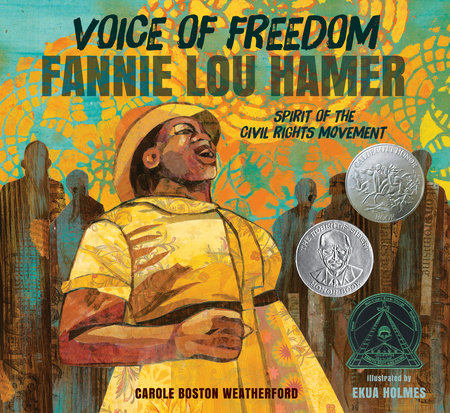 March 1
March 1
Voice of Freedom: Fannie Lou Hamer, Spirit of the Civil Rights Movement
By Carole Boston Weatherford, Ekua Holmes (Illustrator)
We begin the month with Voice of Freedom: Fannie Lou Hamer, Spirit of the Civil Rights Movement about the life of Fannie Lou Hamer. Beautifully written and illustrated, it is one of the too few books about a major figure in the Civil Rights Movement that is not about King, Parks, or Lewis.
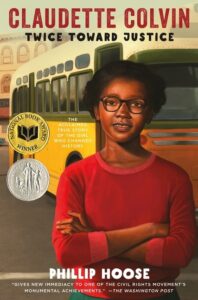 March 2
March 2
Claudette Colvin: Twice Toward Justice
By Phillip M. Hoose
Today is the anniversary of the day (March 2, 1955) when in Montgomery, Alabama, fifteen-year-old Claudette Colvin refused to give up her bus seat to a white woman. This was nine months before Rosa Parks took the same action. Colvin was motivated by what she had been learning in school about African-American history (note this event follows Black History Month) and the U.S. Constitution. Parks knew Colvin from the NAACP Youth Council and was inspired in part to take her action by Colvin. Read more about Colvin in this upper elementary/middle school book and find more resources from Teaching for Change for teaching outside the textbook about the Montgomery Bus Boycott.
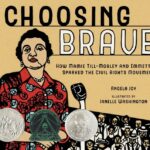 We also recommend Choosing Brave: How Mamie Till-Mobley and Emmett Till Sparked the Civil Rights Movement. This picture book biography powerfully tells the story of the murder of Emmett Till and how his mother channeled her grief into acts of resistance against white supremacy.
We also recommend Choosing Brave: How Mamie Till-Mobley and Emmett Till Sparked the Civil Rights Movement. This picture book biography powerfully tells the story of the murder of Emmett Till and how his mother channeled her grief into acts of resistance against white supremacy.
 March 3
March 3
Separate is Never Equal: Sylvia Mendez and Her Family’s Fight for Desegregation
By Duncan Tonatiuh
This book tells the story of Sylvia Mendez, who was the central figure in the Mendez v. Westminster school desegregation case in California that preceded Brown v. Board of Education. Author and illustrator Duncan Tonatiuh (we LOVE all his books) tells the story of how Mexican-born Gonzalo Mendez and Puerto Rican Felicitas Mendez challenged the separate and unequal school system in California. The award-winning book highlights the story of parent organizing. Winner of the Pura Belpre Award and the Américas Book Award.
 We also recommend Mamie Tape Fights to Go to School, a picture book that tells the true story of a fight for access to public education by an 8-year-old Chinese American girl, Mamie Tape, and her parents.
We also recommend Mamie Tape Fights to Go to School, a picture book that tells the true story of a fight for access to public education by an 8-year-old Chinese American girl, Mamie Tape, and her parents.
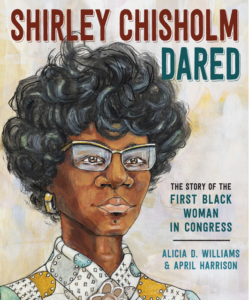 March 4
March 4
Shirley Chisholm Dared: The Story of the First Black Woman in Congress
By Alicia D. Williams, April Harrison (Illustrator)
This book tells the story of Shirley Chisholm, the first African American woman elected to the New York state assembly, the first Black woman in Congress, and the first woman and first African American to seek the nomination for president of the United States from one of the two major political parties. Chisholm was an outspoken voice for laws that that helped women, children, students, poor people, farm workers, Native people, and others who were often ignored.
More Recommendations
 What Do You Do with a Voice Like That? The Story of Extraordinary Congresswoman Barbara Jordan by Chris Barton, illustrated by Ekua Holmes. Jordan was the first African American congresswoman to come from the deep South and in 1966, became the first woman ever elected to the Texas Senate. A remarkable picture book biography about a woman whose struggles and mission continue to inspire today.
What Do You Do with a Voice Like That? The Story of Extraordinary Congresswoman Barbara Jordan by Chris Barton, illustrated by Ekua Holmes. Jordan was the first African American congresswoman to come from the deep South and in 1966, became the first woman ever elected to the Texas Senate. A remarkable picture book biography about a woman whose struggles and mission continue to inspire today.
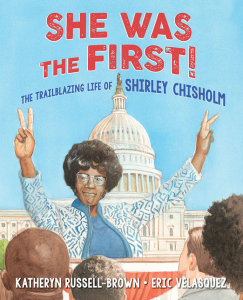 She Was the First! The Trailblazing Life of Shirley Chisholm by Katheryn Russell-Brown, illustrated by Eric Velasquez. Shirley Chisholm, a woman of many firsts, was an unforgettable political trailblazer, a candidate of the people and “catalyst of change” who opened the door for women in the political arena and for the first Black president of the United States.
She Was the First! The Trailblazing Life of Shirley Chisholm by Katheryn Russell-Brown, illustrated by Eric Velasquez. Shirley Chisholm, a woman of many firsts, was an unforgettable political trailblazer, a candidate of the people and “catalyst of change” who opened the door for women in the political arena and for the first Black president of the United States.
March 5
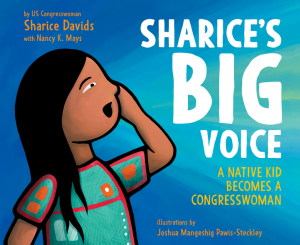 Sharice’s Big Voice
Sharice’s Big Voice
By Sharice Davids with Nancy K. Mays
This picture book autobiography depicts the life of Sharice Davids, one of the first Native American women elected to Congress, and the first LGBTQ congressperson to represent Kansas. As Debbie Reese writes in her review, “The article has key words and definitions, realistic steps for you to take with your students as you begin to fill that silent space, and links to resources to help you. Affirming Indigenous Sovereignty (the article) and Sharice’s Big Voice can be your starting place to make a difference in what your students learn about Native peoples.”
The book’s artwork is beautifully illustrated by Joshua Mangeshig Pawis-Steckley, an Ojibwe Woodland artist.
More Recommendations
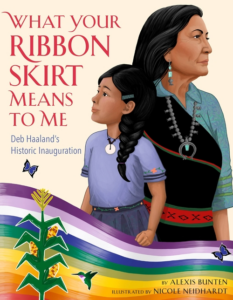 What Your Ribbon Skirt Means to Me: Deb Haaland’s Historic Inauguration, written by Alaska Native Alexis Bunten and illustrated by Nicole Neidhardt, Diné (Navajo) of the Kiiyaa’áanii Clan. The book follows Deb Haaland as she becomes the first Native American to serve as a cabinet secretary.
What Your Ribbon Skirt Means to Me: Deb Haaland’s Historic Inauguration, written by Alaska Native Alexis Bunten and illustrated by Nicole Neidhardt, Diné (Navajo) of the Kiiyaa’áanii Clan. The book follows Deb Haaland as she becomes the first Native American to serve as a cabinet secretary.
Fighter in Velvet Gloves: Alaska Civil Rights Hero Elizabeth Peratrovich by Annie Boochever with Roy Peratrovich Jr. about Native Alaskans fighting for their civil rights in the 1940s. Read a review by Debbie Reese.
Find more books about Native Americans.
 March 6
March 6
Mumbet’s Declaration of Independence
By Gretchen Woelfle, Alix Delinois (Illustrator)
Today marks the anniversary of the horrific SCOTUS ruling in Dred [and Harriet] Scott v. Sandford in 1857 that “Any person descended from Africans, whether slave or free, is not a citizen of the United States, according to the Constitution.” (Harriet Scott filed her own case for freedom that was eventually combined with her husband’s.) We do not know of a good children’s book about Harriet and Dred Scott, so today we highlight Mumbet’s Declaration of Independence.
Readers are introduced to Mumbet, a Black woman enslaved in Massachusetts at the time of the Declaration of Independence in 1776. Knowing that the promise of freedom and equality should belong to her as well, Mumbet successfully brought a lawsuit against her owners to be free and chose the name Elizabeth Freeman. We highly recommend Mumbet’s Declaration of Independence and we suggest reading it to students of all ages before introducing the Dred Scott decision. It shows that people were appealing to the courts for justice throughout the history of slavery and later Jim Crow — and in some all too rare cases (such as Mumbet’s) the courts ruled as they should have — and in others (Dred Scott, Plessy, and many more) the rulings defied the laws of humanity and in fact international human rights laws. Read examples of how teachers used the book in a middle and upper elementary classroom here.
March 6 is Student Activists Day for the Black Lives Matter at School Year of Purpose.
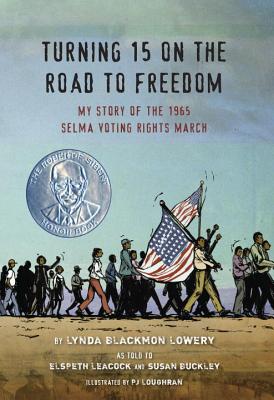 March 7
March 7
Turning 15 on the Road to Freedom: My Story of the 1965 Selma Voting Rights March
By Lynda Blackmon Lowery, Elspeth Leacock, Susan Buckley
On this anniversary of Bloody Sunday in Selma (March 7, 1965), we share this book about Lynda Blackmon Lowery, who was jailed nine times before her fifteenth birthday in her fight for voting rights. Her story shines a light on young people, local people, and women, too often left out of the master narrative about the Civil Rights Movement. We also recommend Selma, Lord, Selma: Girlhood Memories of the Civil Rights Days narrated by Sheyann Webb and Rachel West who were 8 and 9 years old at the time. For these books and more on the history of the Selma to Montgomery Marches visit our recommended booklist for teaching about Selma.
To learn about more women in the Civil Rights Movement, read Hands on the Freedom Plow: Personal Accounts by Women in SNCC.
 March 8
March 8
Rad American Women A-Z
By Kate Schatz, illustrated by Miriam Klein Stahl
On this International Women’s Day, we feature Rad American Women A-Z. Written for middle grade, it includes illustrations and short bios of women from each letter of the alphabet from Angela Davis to Zora Neale Hurston. Featured women include blacklisted musical prodigy Hazel Scott, Mexican-American journalist Jovita Idar and transgender performance artist Kate Bornstein. We need children’s picture books about each of the women featured in this book, as well.
See related books Rad Girls Can: Stories of Bold, Brave, and Brilliant Young Women and Rad Women Worldwide: Artists, Athletes, Pirates and Punks, and Other Revolutionaries Who Shaped History.
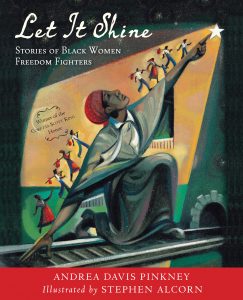 We also recommend Let It Shine: Stories of Black Women Freedom Fighters by Andrea Davis Pinkney and Stephen Alcorn (illustrator). Through the stories of ten freedom fighters, including Sojourner Truth, Mary McLeod Bethune, Fannie Lou Hamer, and Shirley Chisholm, this book inspires the reader to be courageous and determined in the face of oppression and fear.
We also recommend Let It Shine: Stories of Black Women Freedom Fighters by Andrea Davis Pinkney and Stephen Alcorn (illustrator). Through the stories of ten freedom fighters, including Sojourner Truth, Mary McLeod Bethune, Fannie Lou Hamer, and Shirley Chisholm, this book inspires the reader to be courageous and determined in the face of oppression and fear.
 March 9
March 9
Passenger on the Pearl: The True Story of Emily Edmonson’s Flight from Slavery
By Winifred Conkling
Today marks the anniversary of the 1841 Supreme Court ruling in the Amistad case. Less known is the Pearl incident when in 1848, 77 people in Washington, D.C., made a brave and carefully planned escape from slavery. Tragically, they were apprehended. However, the Pearl became a key event in the fight for the abolition of slavery. We highly recommend this book for middle school to adult. There is also a middle school book on the Amistad, Africa Is My Home: A Child of the Amistad.
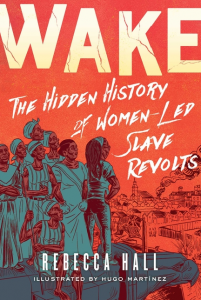 Another recommendation is Wake: The Hidden History of Women-Led Slave Revolts. Part graphic novel, part memoir, Wake is an imaginative tour-de-force that tells the story of women-led slave revolts and chronicles scholar Rebecca Hall’s efforts to uncover the truth about these women warriors who, until now, have been left out of the historical record.
Another recommendation is Wake: The Hidden History of Women-Led Slave Revolts. Part graphic novel, part memoir, Wake is an imaginative tour-de-force that tells the story of women-led slave revolts and chronicles scholar Rebecca Hall’s efforts to uncover the truth about these women warriors who, until now, have been left out of the historical record.
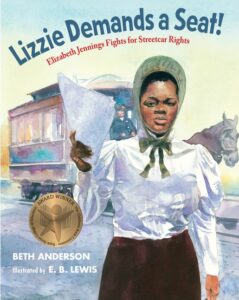 March 10
March 10
Lizzie Demands a Seat! Elizabeth Jennings Fights for Streetcar Rights
By Beth Anderson, illustrated by E. B. Lewis
In 1854, Elizabeth “Lizzie” Jennings, an African American schoolteacher, fought back when she was unjustly denied entry to a New York City streetcar, sparking the beginnings of the long struggle to gain equal rights on public transportation.
One hundred years before Rosa Parks took her stand, Elizabeth “Lizzie” Jennings tried to board a streetcar in New York City on her way to church. Though there were plenty of empty seats, she was denied entry, assaulted, and threatened all because of her race — even though New York was a free state at that time. Lizzie decided to fight back. She told her story, took her case to court — where future president Chester Arthur represented her — and won!
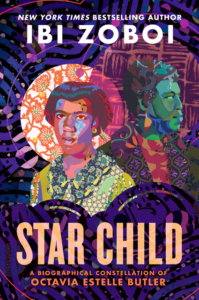 March 11
March 11
Star Child: A Biographical Constellation of Octavia Estelle Butler
By Ibi Zoboi
Acclaimed novelist Ibi Zoboi illuminates the young life of the visionary storyteller Octavia E. Butler in poems and prose. Born into the Space Race, the Red Scare, and the dawning Civil Rights Movement, Butler experienced an American childhood that shaped her into the groundbreaking science-fiction storyteller whose novels continue to challenge and delight readers years after her death.
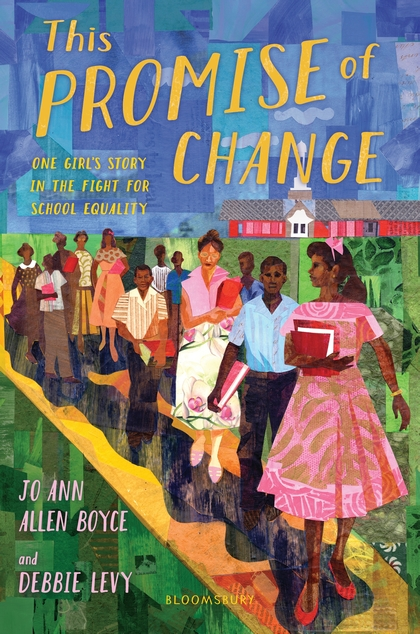 March 12
March 12
This Promise of Change: One Girl’s Story in the Fight for School Equality
By Jo Ann Allen Boyce, Debbie Levy
This dramatic story is told by one of the 12 students — Jo Ann Allen Boyce (in collaboration with children’s book author Debbie Levy), who desegregated their high school in Clinton, Tennessee, one year before the more well-known Little Rock Nine. To tell the powerful story, the authors use free verse interspersed with quotes from newspapers, white supremacist protest signs, preachers’ sermons, and other primary documents from the time. Read a review.
More Recommendations
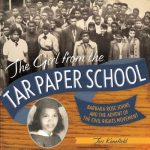 The Girl from the Tar Paper School: Barbara Rose Johns and the Advent of the Civil Rights Movement by Teri Kanefield. Lessons on Brown v. Board of Education should not begin with the 1954 Supreme Court decision but, instead, with the decades of activism that led to the historic ruling. And there is no better way to hook students than with the school walkout led by 15-year-old Barbara Rose Johns in Prince Edward County, Virginia, in 1951.
The Girl from the Tar Paper School: Barbara Rose Johns and the Advent of the Civil Rights Movement by Teri Kanefield. Lessons on Brown v. Board of Education should not begin with the 1954 Supreme Court decision but, instead, with the decades of activism that led to the historic ruling. And there is no better way to hook students than with the school walkout led by 15-year-old Barbara Rose Johns in Prince Edward County, Virginia, in 1951.
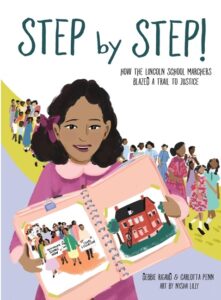 Step by Step! How the Lincoln School Marchers Blazed a Trail to Justice, the true story of Black mothers in Hillsboro, Ohio, who attempted to enroll their children at the all-white Webster School following the landmark Brown v. Board of Education decision. However, the local school board refused the call for integration. Demanding equal education, a group of Black mothers and children marched to and from Webster daily until Black students were admitted.
Step by Step! How the Lincoln School Marchers Blazed a Trail to Justice, the true story of Black mothers in Hillsboro, Ohio, who attempted to enroll their children at the all-white Webster School following the landmark Brown v. Board of Education decision. However, the local school board refused the call for integration. Demanding equal education, a group of Black mothers and children marched to and from Webster daily until Black students were admitted.
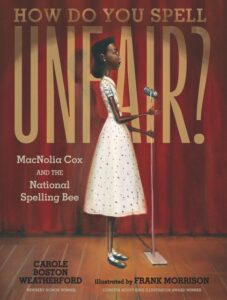 How Do You Spell Unfair?, the true story of young spelling champion MacNolia Cox, by Carole Boston Weatherford and illustrated by Frank Morrison. Weatherford cleverly challenges the reader to spell various thematic words that add structure to the story arc, including “racism” and “discrimination,” and ending with “amazing” and “proud.” As a read-aloud, this provides interactive opportunities for engagement.
How Do You Spell Unfair?, the true story of young spelling champion MacNolia Cox, by Carole Boston Weatherford and illustrated by Frank Morrison. Weatherford cleverly challenges the reader to spell various thematic words that add structure to the story arc, including “racism” and “discrimination,” and ending with “amazing” and “proud.” As a read-aloud, this provides interactive opportunities for engagement.
March 12 is the anniversary of the Capitol Crawl in 1990, one the most influential protests of the disability rights movement. There is a children’s picture book about 8-year-old activist Jennifer Keelan-Chafins who participated in that event.
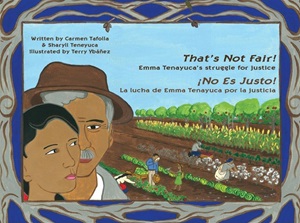 March 13
March 13
That’s Not Fair! Emma Tenayuca’s Struggle for Justice/¡No Es Justo!: La lucha de Emma Tenayuca por la justicia
By Carmen Tafolla, Sharyll Teneyuca and Celina Marroquin
This book for elementary age children is about Emma Tenayuca, born in born in San Antonio, Texas in 1916. Through her work as an educator, speaker, and labor organizer, Tenayuca became known as “La Pasionaria.” From 1934-48, she supported almost every strike in the city, writing leaflets, visiting homes of strikers, and joining them on picket lines.
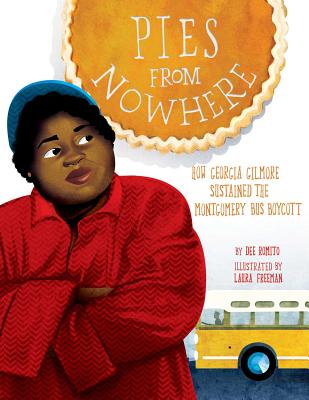 March 14
March 14
Pies from Nowhere: How Georgia Gilmore Sustained the Montgomery Bus Boycott
By Dee Romito
This beautifully illustrated picture book highlights a hidden figure of the civil rights movement who fueled the bus boycotts. It tells the story of Georgia Gilmore and the Club from Nowhere — a grassroots project of maids, service workers, and cooks who provided food and funds for the Montgomery Bus Boycott. Georgia Gilmore was an excellent cook and baker who used her skills to fight injustice. When the citywide boycott began, Gilmore supported the cause using her remarkable culinary ability and creative thinking, along with other women, they sold their food, using proceeds to support many aspects of the boycott.
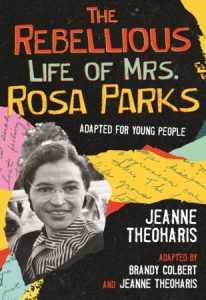 March 15
March 15
The Rebellious Life of Mrs. Rosa Parks: Adapted for Young People
By Jeanne Theoharis, Adapted by Jeanne Theoharis and Brandy Colbert
Rosa Parks is one of the most well-known Americans today, but much of what is known and taught about her is incomplete, distorted, and just plain wrong. Adapted for young people from the NAACP Image Award-winning The Rebellious Life of Mrs. Rosa Parks, Jeanne Theoharis and Brandy Colbert shatter the myths that Parks was meek, accidental, tired, or middle class. They reveal a lifelong freedom fighter whose activism began two decades before her historic stand that sparked the Montgomery bus boycott and continued for 40 years after.
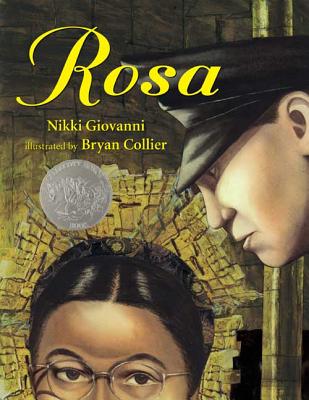 For younger readers, we recommend Rosa by Nikki Giovanni and illustrated by Bryan Collier. Rosa is one of the very few children’s books on the Montgomery Bus Boycott to place the roles of Rosa Parks and Dr. King in the context of a movement with a long history and led by women.
For younger readers, we recommend Rosa by Nikki Giovanni and illustrated by Bryan Collier. Rosa is one of the very few children’s books on the Montgomery Bus Boycott to place the roles of Rosa Parks and Dr. King in the context of a movement with a long history and led by women.
More resources for teaching about Parks and the Montgomery Bus Boycott are available at our Civil Rights Teaching website.
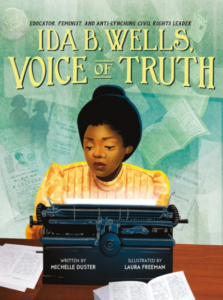 March 16
March 16
Ida B. Wells, Voice of Truth: Educator, Feminist, and Anti-Lynching Civil Rights Leader
By Michelle Duster, illustrated by Laura Freeman
Ida B. Wells was an educator, journalist, feminist, businesswoman, newspaper owner, public speaker, suffragist, civil rights activist, and women’s club leader. She was a founder of the NAACP, the National Association of Colored Women’s Clubs, the Alpha Suffrage Club, and the Negro Fellowship League.
She wrote, spoke, and traveled, challenging the racist and sexist norms of her time. Faced with criticism and threats to her life, she never gave up.
This is her extraordinary true story, as told by her great-granddaughter Michelle Duster and beautifully brought to life by Coretta Scott King Award Honoree artist Laura Freeman.
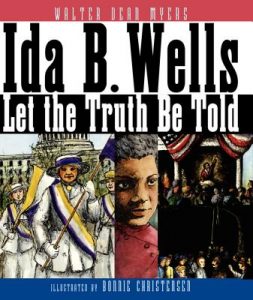 We also recommend Ida B. Wells: Let the Truth Be Told by Walter Dean Myers and Bonnie Christensen (Illustrator). Born into slavery during the Civil War, Ida B. Wells fought hard to better the lives of African Americans and women. This book follows her life from her schooling, raising her siblings after the death of her parents, to her rise to national fame as a journalist, speaker, and anti-lynching activist.
We also recommend Ida B. Wells: Let the Truth Be Told by Walter Dean Myers and Bonnie Christensen (Illustrator). Born into slavery during the Civil War, Ida B. Wells fought hard to better the lives of African Americans and women. This book follows her life from her schooling, raising her siblings after the death of her parents, to her rise to national fame as a journalist, speaker, and anti-lynching activist.
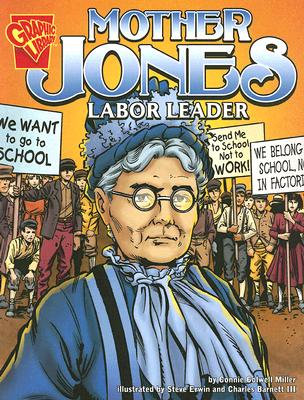 March 17
March 17
Mother Jones: Labor Leader
By Connie C. Miller, Steve Erwin (Illustrator), Charles Barnett, III (Illustrator)
For Saint Patrick’s Day, the Woman’s History Month Book of the Day is the graphic novel, “Mother Jones: Labor Leader.” Mary Harris “Mother” Jones learned firsthand about injustice when she was a young girl living in Cork County, Ireland. As the potato blight starved the poor, their landlords exported grain and meat — food that could have prevented those deaths. Learn more.
Her family immigrated to North America in the 1850s. After her husband and four children died from yellow fever, Mother Jones dedicated her life to workers’ rights. Jones earned the label “the most dangerous woman in America” by using new organizing strategies that involved women and children in strikes. She organized miners’ wives into teams armed with mops and brooms to guard the mines against scabs and staged parades with children carrying signs that read, “We Want to Go to School and Not to the Mines.”
More Recommendations
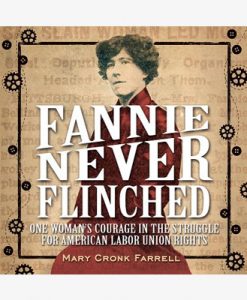 Fannie Never Flinched: One Woman’s Courage in the Struggle for American Labor Rights by Mary Cronk Farrell. Full of photos and primary documents, Fannie Never Flinched puts Sellins’ story in the context of the struggles of workers and the labor movement during the “Gilded Age.” As Farrell, a skilled and engaging nonfiction writer, explains in the author’s note, during the research for the book she realized that the murder of Sellins is part of a much larger pattern of violence against working people.
Fannie Never Flinched: One Woman’s Courage in the Struggle for American Labor Rights by Mary Cronk Farrell. Full of photos and primary documents, Fannie Never Flinched puts Sellins’ story in the context of the struggles of workers and the labor movement during the “Gilded Age.” As Farrell, a skilled and engaging nonfiction writer, explains in the author’s note, during the research for the book she realized that the murder of Sellins is part of a much larger pattern of violence against working people.
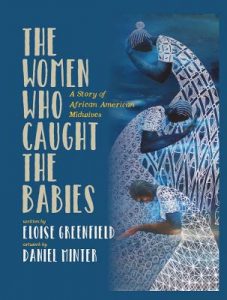 March 18
March 18
The Women Who Caught the Babies: A Story of African American Midwives
By Eloise Greenfield, illustrated by Daniel Minter
This unique picture book begins with an essay on the history of midwives, written in prose that is accessible to young readers and accompanied by archival photographs. The book then switches to poetry and stunningly beautiful illustrations — with vignettes from lives of midwives during slavery, emancipation, and today. Greenfield closes with a poem about Miss Rovenia Mayo of Parmele, North Carolina, the midwife who “caught” her when she was born.
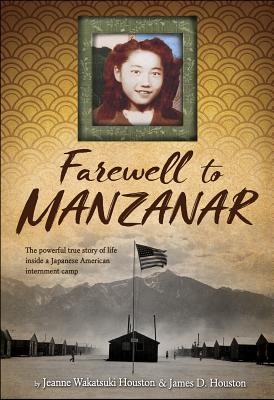 March 19
March 19
Farewell to Manzanar: A True Story of Japanese-American Experience during and after the World War II Internment
By Jeanne Wakatsuki Houston, James D. Houston
Born in California, Jeanne Wakatsuki Houston was seven years old when her family was forced into the Manzanar internment camp near the Sierra Nevada mountains in Nevada, along with more than 11,000 other Japanese Americans. The memoir describes the Wakatsuki family’s strategies for surviving internment and the harmful effects it had on their family.
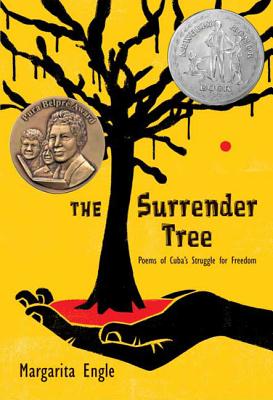 March 20
March 20
The Surrender Tree: Poems of Cuba’s Struggle for Freedom/El Arbol de La Rendicion: Poemas de La Lucha de Cuba Por Su Libertad
By Margarita Engle
Today’s Women’s History Month Book of the Day, in English and Spanish, is about the life of legendary nurse Rosa la Bayamesa during Cuba’s long fight for independence in the 19th century. The book includes the seldom told story of the reconcentration camps that led to the death of 400,000 Cubans. Too often, popular knowledge of Cuba begins and ends with name recognition of the Cuban Revolution, the Cuban Missile Crisis, and Fidel Castro. Spanning the years 1850–1899, Engle’s poems tell the story of Cuba’s Wars for Independence. Our thanks to Margarita Engle for this and many more invaluable books for elementary and middle school on Cuba, including Drum Dream Girl.
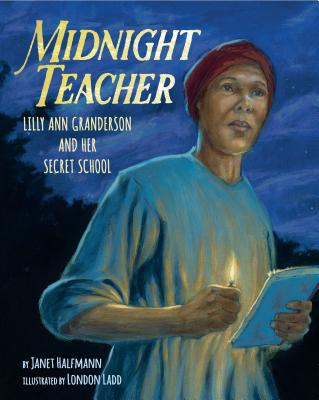 March 21
March 21
Midnight Teacher: Lilly Ann Granderson and Her Secret School
By Janet Halfmann, London Ladd (illustrator)
Lilly Ann Granderson was an enslaved woman born around 1821. After her mother’s death, she was sent to Kentucky where the plantation owners’ children often played school with Granderson. As a result, she learned to read and went on to teach others in secrecy. After the plantation owner’s death, she was sold to a cotton plantation in Natchez, Mississippi, where it was illegal for people who were enslaved to learn to read. Undeterred, Granderson expanded her education efforts.
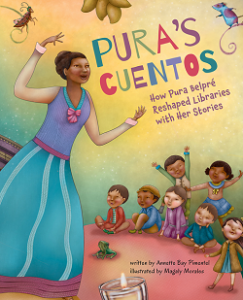 March 22
March 22
Pura’s Cuentos
By Annette Bay Pimentel
In this book, children are taken on Pura Belpré’s journey of how she came to be a transformational figure in the library system by pioneering bilingual storytelling and making library services accessible to the Latinx community.
 We also recommend Go Forth and Tell: The Life of Augusta Baker, Librarian, and Master Storyteller, the true story of Augusta Braxton Baker, who championed books, writers, librarians, and teachers centering Black stories, educating and inspiring future acclaimed authors like Audre Lorde and James Baldwin along the way.
We also recommend Go Forth and Tell: The Life of Augusta Baker, Librarian, and Master Storyteller, the true story of Augusta Braxton Baker, who championed books, writers, librarians, and teachers centering Black stories, educating and inspiring future acclaimed authors like Audre Lorde and James Baldwin along the way.
 March 23
March 23
Never Caught, the Story of Ona Judge: Young Readers Edition
By Erica Armstrong Dunbar & Kathleen Van Cleve
“This book, the young readers’ version of Erica Armstrong Dunbar’s Never Caught — a 2017 National Book Award finalist in nonfiction — is a welcome, compelling corrective to the whitewashed version of Revolutionary-era history…a story in which the Anglo men were heroes, the black people were nameless, and slavery was simply, unquestionably, The Way Things Were.” – Anndee Hochman, Broadstreetreview.com
Born into slavery, Ona Judge made a courageous (and dangerous) escape from the most powerful couple in the country, George and Martha Washington. This is her bold and brave story.
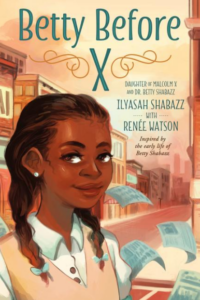 March 24
March 24
Betty Before X
By Ilyasah Shabazz and Renee Watson
In Detroit, 1945, eleven-year-old Betty’s house doesn’t quite feel like home. She believes her mother loves her, but she can’t shake the feeling that her mother doesn’t want her. Church helps those worries fade, if only for a little while. The singing, the preaching, the speeches from guest activists like Paul Robeson and Thurgood Marshall stir African Americans in her community to stand up for their rights. Betty quickly finds confidence and purpose in volunteering for the Housewives League, an organization that supports black-owned businesses. Soon, the American civil rights icon we now know as Dr. Betty Shabazz is born.
 March 25
March 25
Someday Is Now: Clara Luper and the 1958 Oklahoma City Sit-ins
By Olugbemisola Rhuday-Perkovich, illustrated by Jade Johnson
Introduce students to the activism of Clara Luper, an African American high school teacher who organized lunch counter sit-ins for her students to protest segregation in 1958. The narrative functions as a history lesson and as a guide for when and how to challenge injustice (now and with nonviolent direct action). The author does not shy away from describing the humiliating abuse the children suffered during the sit-in. The artist shows images of Black children covered in food while white patrons yell, throw, and shake their fists. The art is simple but stunning.
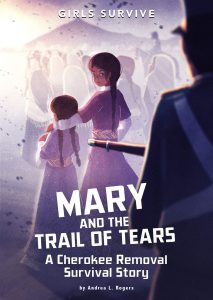 March 26
March 26
Mary and the Trail of Tears: A Cherokee Removal Survival Story
By Andrea L. Rogers
On this day, the anniversary of the day in 1839 when the Cherokee came to the end of the forced death march from their ancestral home to the Oklahoma Territory, we share Mary and the Trail of Tears: A Cherokee Removal Survival Story. Written by a Cherokee citizen and featuring nonfiction support material, this story explores the tragedy of forced removals following the Indian Removal Act of 1830. Facing horrors such as internment, violence, disease, and harsh weather, Mary perseveres and helps keep her family and friends together until they can reach the new Cherokee nation in Indian Territory.
 March 27
March 27
A Bigger Picture: My Fight to Bring a New African Voice to the Climate Crisis
By Vanessa Nakate
In today’s book, A Bigger Picture, Vanessa Nakate shares her story as a young Ugandan woman who sees that her community bears disproportionate consequences to the climate crisis. At the same time, she sees that activists from African nations and the global south are not being heard in the same way as activists from white nations are heard. Inspired by Sweden’s Greta Thunberg, in 2019 Nakate became Uganda’s first Fridays for Future protestor, awakening to her personal power and summoning within herself a commanding political voice.
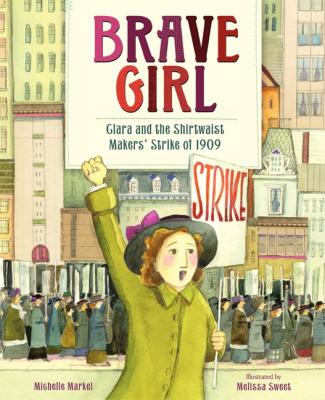 March 28
March 28
Brave Girl: Clara and the Shirtwaist Makers’ Strike of 1909
By Michelle Markel, illustrated by Melissa Sweet
The book of the day is about Clara Lemlich, born March 28, 1886 in Ukraine who said:
I have listened to all the speakers, and I have no further patience for talk. I am a working girl, one of those striking against intolerable conditions. I am tired of listening to speakers who talk in generalities. What we are here for is to decide whether or not to strike. I make a motion that we go out in a general strike.
Read about Clara Lemlich at Women and the American Story via the New York Historical Society. The profile begins,
Clara Lemlich Shavelson was born in 1886 in Gorodok, Ukraine. She did not receive a formal education because there were no Jewish schools for girls. But Clara did not let this stop her. She borrowed books from neighbors and hid them in her attic. She was fascinated with Karl Marx and communism. By the time she was a teenager, Clara had formed her own beliefs about the challenges of working-class people.
When Clara was 17, her parents decided to move to America and escape the violence against Jews spreading in Europe. Within two weeks of arriving on New York’s Lower East Side, Clara was working in a garment factory. Because her father found it hard to find a permanent job, Clara was often the primary breadwinner for her family. Continue reading.
March 29
Mamie on the Mound: A Woman in Baseball’s Negro Leagues
By Leah Henderson, illustrated by George Doutsiopoulos
Mamie “Peanut” Johnson was a talented baseball player, but she wasn’t welcome in the segregated All-American Girls Pro Baseball League due to the color of her skin. In 1953, she signed to play ball for the Negro Leagues’ Indianapolis Clowns, becoming the first female pitcher to play on a men’s professional team. During the three years she pitched for the Clowns, her record was an impressive 33-8. But more importantly, she broke ground for other female athletes and for women everywhere.
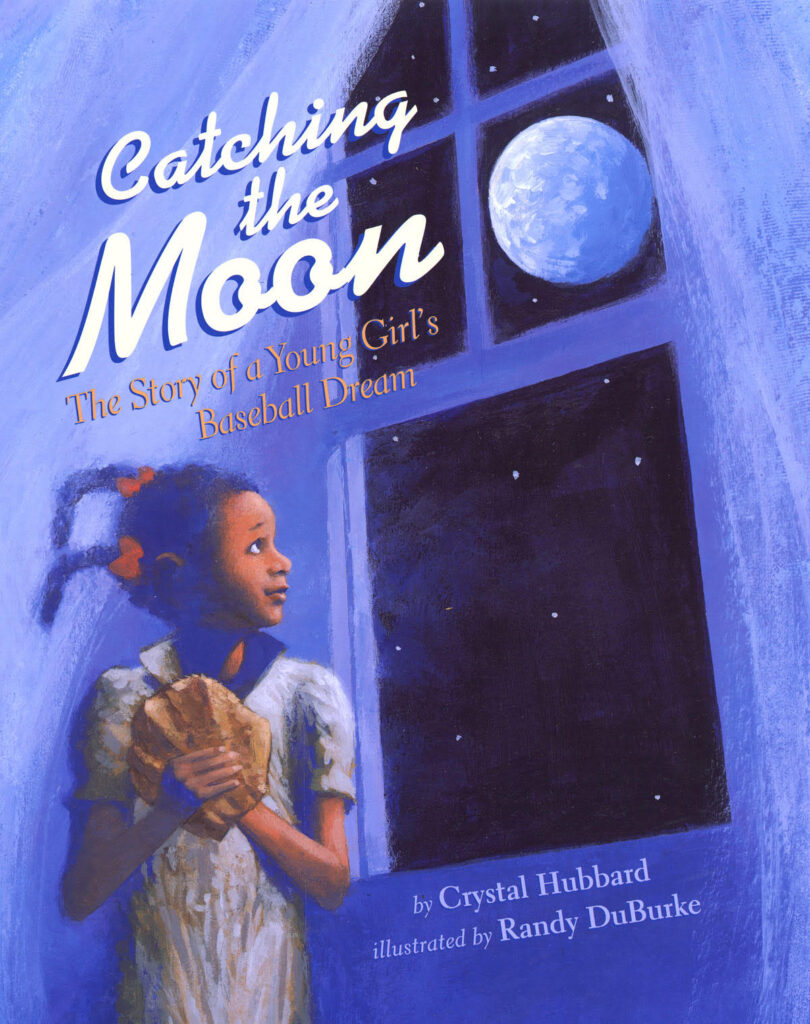 Three women played Negro league baseball (women never played in the white major leagues). You can read about Marcenia Lyle Toni Stone, the first woman to play in the Negro leagues, in Catching the Moon: The Story of a Young Girl’s Baseball Dream by Crystal Hubbard.
Three women played Negro league baseball (women never played in the white major leagues). You can read about Marcenia Lyle Toni Stone, the first woman to play in the Negro leagues, in Catching the Moon: The Story of a Young Girl’s Baseball Dream by Crystal Hubbard.
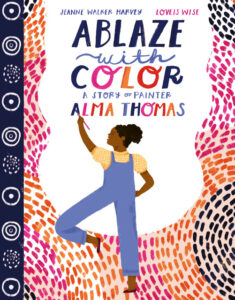 March 30
March 30
Ablaze with Color: A Story of Painter Alma Thomas
By Jeanne Walker Harvey, illustrated by Loveis Wise
Meet an incredible woman who broke down barriers throughout her life and is now known as one of the most preeminent painters of the 20th century. Told from the point of view of young Alma Thomas, readers can follow along as she grows into her discovery of the life-changing power of art.
As a child in Georgia, Alma Thomas loved to spend time outside, soaking up the colors around her. And her parents filled their home with color and creativity despite the racial injustices they faced. After the family moved to Washington, D.C., Alma shared her passion for art by teaching children. When she was almost seventy years old, she focused on her own artwork, inspired by nature and space travel.
In this celebration of art and the power of imagination, Jeanne Walker Harvey and Loveis Wise tell the incredible true story of Alma Thomas, the first Black woman to have a solo exhibition at the Whitney Museum in New York City and to have her work chosen for the White House collection. With her bold and vibrant abstract paintings, Alma set the world ablaze with color.
More Recommendations
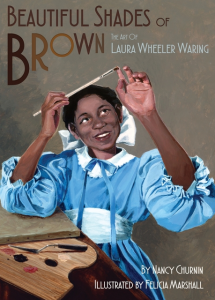 Beautiful Shadows of Brown: The Art of Laura Wheeler Waring by Nancy Churnin and Felicia Marshall (Illustrator). Growing up in the late 19th century, Laura Wheeler Waring didn’t see any artists who looked like her. She didn’t see any paintings of people who looked like her, either. As a young woman studying art in Paris, she found inspiration in the works of Matisse and Gauguin to paint the people she knew best. Back in Philadelphia, the Harmon Foundation commissioned her to paint portraits of accomplished African Americans. Her portraits still hang in Washington, D.C.’s National Portrait Gallery, where children of all races can admire the beautiful shades of brown she captured.
Beautiful Shadows of Brown: The Art of Laura Wheeler Waring by Nancy Churnin and Felicia Marshall (Illustrator). Growing up in the late 19th century, Laura Wheeler Waring didn’t see any artists who looked like her. She didn’t see any paintings of people who looked like her, either. As a young woman studying art in Paris, she found inspiration in the works of Matisse and Gauguin to paint the people she knew best. Back in Philadelphia, the Harmon Foundation commissioned her to paint portraits of accomplished African Americans. Her portraits still hang in Washington, D.C.’s National Portrait Gallery, where children of all races can admire the beautiful shades of brown she captured.Art from Her Heart: Folk Artist Clementine Hunter by Kathy Whitehead. Born in 1886 in Louisiana, Clementine Hunter picked cotton on the Melrose Plantation and was a talented artist. She was the first African American artist to have a solo exhibition at the Delgado Museum (now the New Orleans Museum of Art). The book describes how a friend brought Hunter into one of her own exhibits when the gallery was closed because as an African American, Hunter was not allowed to enter.
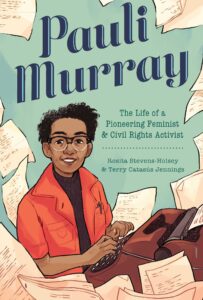 March 31
March 31
Pauli Murray: The Life of a Pioneering Feminist and Civil Rights Activist
By Terry Catasús Jennings, Rosita Stevens-Holsey, and illustrated by Ashanti Fortson
Pauli Murray was a trailblazer who spent her life fighting for civil rights and women’s rights. Writer, lawyer, activist, priest, Pauli was a champion for justice. Her life is immortalized in this riveting biography told in verse.
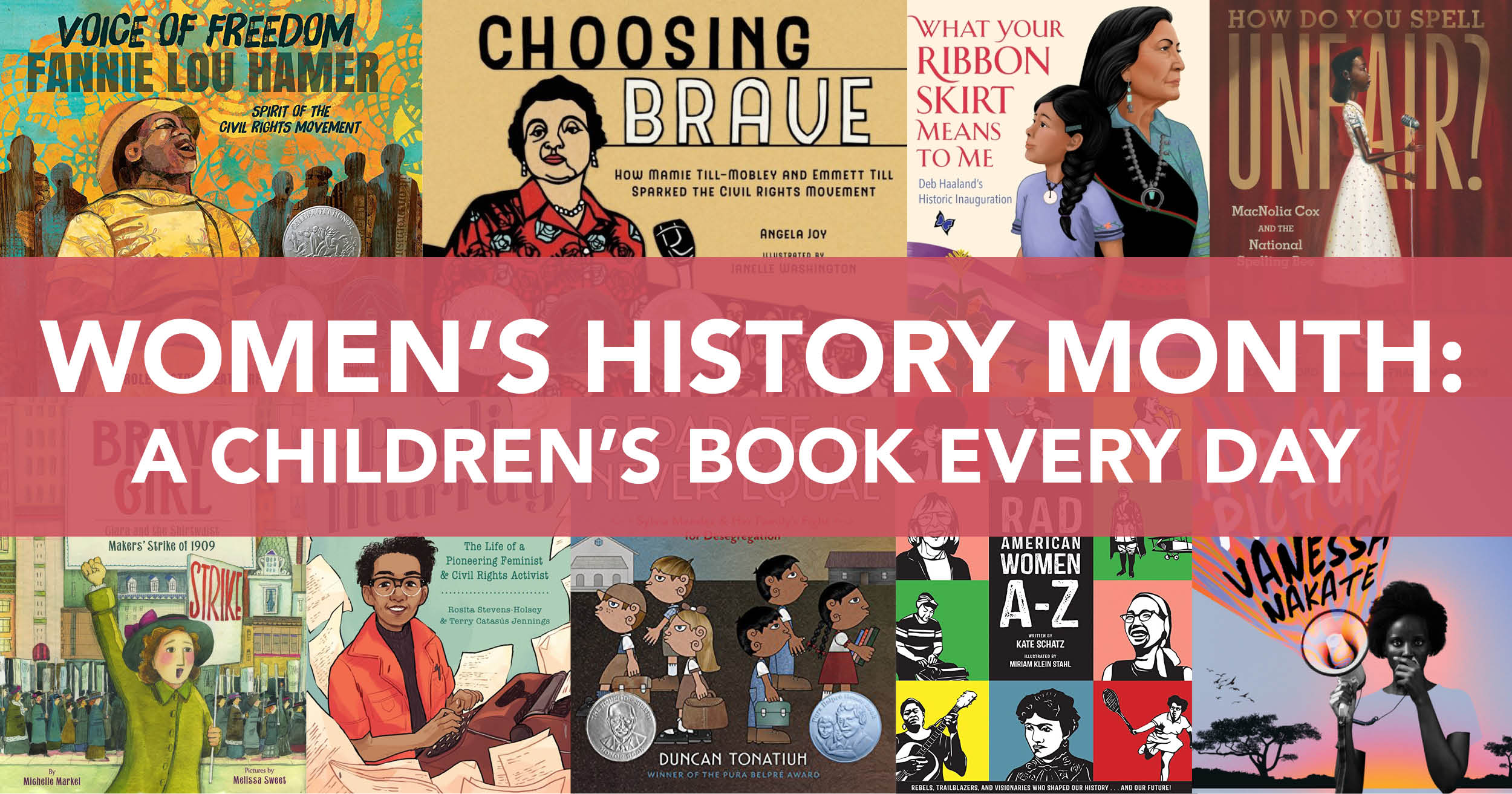
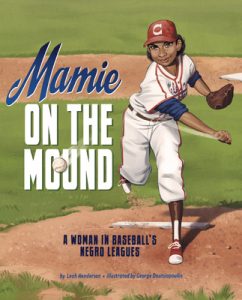

Leave a Reply